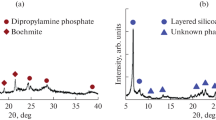Abstract
Single phase (type I) mullite gels were prepared by sol-gel techniques starting from alkoxides (Al-butylate, tetraethylorthosilicate) and alkoxides plus nitrates (tetraethylorthosilicate, Al(NO3)3·9H2O). After drying at 150°C the aluminosilicate gels are non-crystalline and remain so up to ≈ 900°C. Above 900°C the gels transform into Al2O3-rich mullite plus a coexisting SiO2 phase. Structural studies on temperature-dependent dehydroxylation and condensation of the gels were carried out by large angle X-ray scattering, by infrared spectroscopy and by29 Si NMR spectroscopy. Heat-treatment (<150°C) of dried gels first causes removal of the H2O and organic residuals weakly bound at the open pore surfaces of the gels while the stronger, structurally bound OH groups are not affected. At temperatures <600°C OH groups are released and recombine to molecular H2O. If the temperature does not exceed 800°C the newly formed H2O is trapped in closed nanopores of the gel-network. Corresponding electron microscopical investigations reveal agglomerates of ≈10 nm sized primary particles virtually unaffected by the heat-treatment below 900°C. NMR investigation provided a new structural model on type and distribution of coordination polyhedra in aluminium silicate gel networks. Unlike Si, which according to 29Si NMR is always 4-fold coordinated with O, 27Al NMR spectroscopy revealed that Al cordination is more complex and is influenced by thermal treatment. Al occurs six-fold (octahedrally) and four-fold (tetrahedrally) coordinated. A third 27Al NMR signal which has been attributed to five-fold-coordinated Al in the literature increased in intensity with the heat-treatment. A comparison of NMR data of the gels with those of mullite suggests that tetrahedra triclusters (3 tetrahedra having one oxygen atom in common) occur as major structural units in aluminium silicate gels rather than five-fold-coordinated Al. Triclusters of tetrahedra may compensate the excess negative charge in the network caused by Si4+ → Al3+ substitution. The charge compensation model is supported by aluminosilicate gels doped with network modifiers (e.g., Na+). Since equimolar addition of Na+ compensates Si4+ → Al3+ substitution the formation of triclusters is no longer required which actually can be deduced from27 Al NMR studies.
Similar content being viewed by others
References
1._I.A. Aksay, D.M. Dabbs, and M. Sarikaya, J. Amer. Ceram. Soc. 74, 2343 (1991).
H. Schneider, K. Okada, and J.A. Pask, Mullite and Mullite Ceramics (John Wiley & Sons, Chichester, 1994).
H. Schneider, D. Voll, B. Saruhan, J. Sanz, G. Schrader, C. Rüscher, and A. Mosset, J. Non-Cryst. Solids 178, 262 (1994).
M. Schmücker, H. Schneider, M. Poorteman, F. Cambier, and R.J. Meinhold, J. Europ. Ceram. Soc. 15, 1201 (1995).
M. Schmücker, W. Hoffbauer, unpublished results.
H. Schneider, L. Merwin, and A. Sebald, J. Mater. Sci. 27, 805 (1992).
H.A. Levy, M.D. Danford, and A.H. Narten, Rept. No. ORNL-3960, Oak Ridge Natl. Lab., Tenn., 61 (1966)
J. Krogh-Moe, A method for converting experimental X-ray intensities to an absolute scale, Acta Cryst. 9, 951 (1956).
B.E. Yoldas and D.E. Partlow, J. Mater. Sci. 27, 805 (1992).
K. Okada and N. Otsuka, J. Amer. Ceram. Soc. 69, 652 (1986).
Ph. Colomban, J. Mater. Sci. 24, 3011 (1989).
D. Voll, Ph.D. Thesis, University of Hannover, 1995.
W.G. Fahrenholz, S.L. Hietala, D.M. Smith, A.J. Hurd, C.J. Brinker, and W.L. Earl, MRS Proceedings 180, 229 (1990).
T. Heinrich and F. Raether, J. Non-Cryst. Solids 147/148, 152 (1992).
D.W. Hoffmann, R. Roy, and S. Komarneni, J. Amer. Ceram. Soc. 67, 468 (1984).
W.E. Cameron, Am. Ceram. Soc. Bull. 56, 1003 (1977).
M. Fukuoka, Y. Onoda, S. Inoue, K. Wada, A. Nukui, and A. Makashima J. Sol-Gel Sci. Tech. 1, 47 (1993).
J.C. Pouxviel and J.P. Boilot, J. Mater. Sci. 24, 321 (1989).
J.C. Pouxviel, J.P. Boilot, A. Lecomte, and A. Dauger, J. Phys. 48, 921 (1987).
I. Jaymes and A. Douy, J. Europ. Ceram. Soc. 16, 155 (1996).
D.X. Li and W.J. Thomson, J. Amer. Ceram. Soc. 73, 964 (1990).
K.J.D. Mackenzie, R.H. Meinhold, J.E. Patterson, H. Schneider, M. Schmücker, and D. Voll, J. Europ. Ceram. Soc. 16, 1299 (1996).
D. Voll, A. Beran, and H. Schneider, J. Europ. Ceram. Soc. 18, 1101 (1998).
S. H. Risbud, R.J. Kirkpatrick, A.P. Taglialavore, and B. Montez, J. Amer. Ceram. Soc. 70, c10 (1987).
M. Mägi, E. Lipmaa, A. Samoson, G. Engelhardt, and A.R. Grimmer, J. Phys. Chem. 88, 1518 (1984).
G. Engelhardt and D. Michel, High Resolution Solid State NMR of Silicates and Zeolithes (John Wiley and Sons, New York, 1987).
M. Okuno, Y. Shimada, M. Schmücker, H. Schneider, W. Hoffbauer, and M. Jansen, J. Non-Cryst. Solids 210, 41 (1997).
C. Gerardin, S. Sundaresan, J. Bernziger, and A. Navrotsky, Chem. Mater. 6, 160 (1994).
A. Taylor and D. Holland, J. Non-Cryst. Solids 152, 1 (1993).
R.H. Meinhold, R.C.T. Slade, and T.W. Davies, Appl. Magn. Reson. 4, 141 (1993).
M. Schmücker and H. Schneider, Ber. Bunsenges. Phys. Chem. 100, 1550 (1996).
C.W. Burnham and M.J. Buerger, Z. Krist. 115, 269 (1961).
L.B. Alemany and G.W. Kirker, J. Amer. Chem. Soc. 108, 6158 (1986).
R.K. Sato, P.F. McMillan, P. Dennison, and R. Dupree, J. Phys. Chem. 95, 4483 (1991).
E.D. Lacy, Phys. Chem. Glasses 4, 234 (1963).
C.W. Burnham, Carnegie Inst.Wash. Year Book 63, 223 (1964).
R.J. Angel and C.T. Prewitt, Amer. Min. 71, 1476 (1986).
Author information
Authors and Affiliations
Rights and permissions
About this article
Cite this article
Schmücker, M., Schneider, H. Structural Development of Single Phase (Type I) Mullite Gels. Journal of Sol-Gel Science and Technology 15, 191–199 (1999). https://doi.org/10.1023/A:1008786023100
Issue Date:
DOI: https://doi.org/10.1023/A:1008786023100




